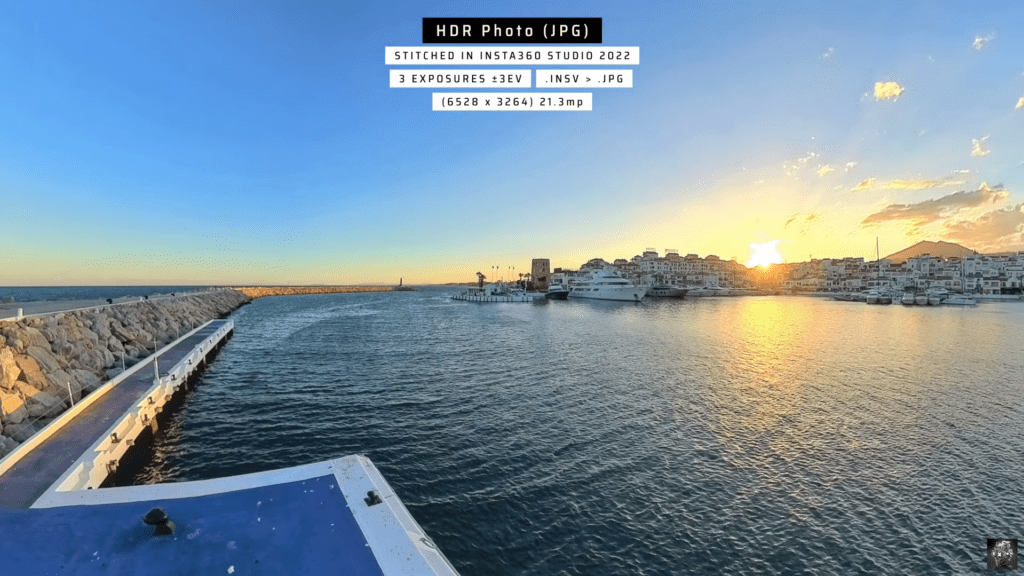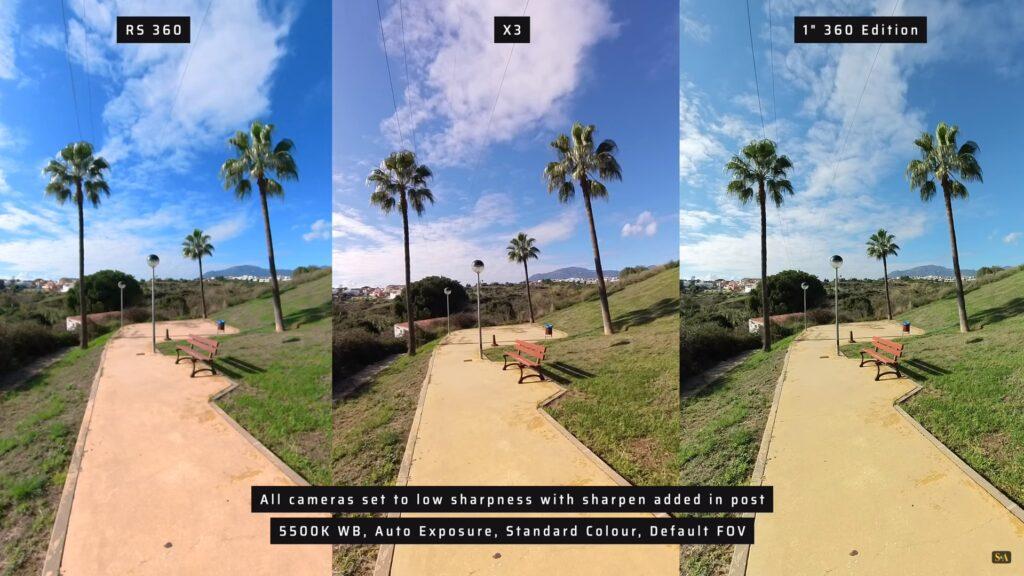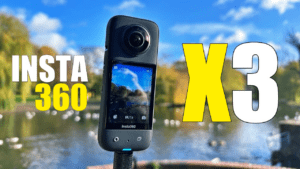360 cameras have become increasingly popular among digital nomads, as they offer the ability to capture immersive footage that can be shared with friends and followers on social media. In this article, we will be comparing the Insta360 X3, Insta360 RS, and Insta360 RS 1-inch 360 editions, three of the latest and most advanced 360 cameras on the market.
As a digital nomad and a 360 camera enthusiast, I’ve had the opportunity to test these cameras in a variety of settings and activities, such as biking, hiking, and traveling. In this article, I will be sharing my personal experience and insights on the performance, features, and specifications of each camera, as well as some tips and recommendations for digital nomads looking to invest in a 360 camera. So, whether you’re a vlogger, a content creator, or just an avid traveler, keep reading to find out which of these cameras is best suited to your needs.
360 Video & Photo Review
360 Video Comparison of Insta360 Editions
When it comes to dedicated 360 video performance, Insta360 RS 1 inch Edition stands out as the best 360 camera for image quality. The camera’s one-inch sensors not only improve low-light performance, but also enhance full daylight performance. With lower noise levels, the images produced by the 1-inch Edition are sharper and clearer, especially when cropping and reframing shots. When comparing 360 cameras, Insta360 X3, Insta360 RS and the Insta360 1-inch Edition, the newer technology and bigger sensor sizes of the X3 and the 1-inch edition do bring additional benefits, such as a sharper image when punching in. All in all, the Insta360 1-inch Edition is the best 360 camera for video quality among these three options.

360 Photo Comparison of Insta360 Editions
Insta360 RS 1-inch Edition is the best camera among the three options. The camera’s 21.3 megapixel 360 2×1 equirectangular photos offer low noise and high resolution thanks to its bigger sensor. This makes the 1-inch edition RS a natural choice for professionals looking to do real estate tours, as well as other professional photography works such as landscape, nature, and nomadic travel photography. The 1-inch Edition outperforms the other options in the space, making it a great value for the cost.
All three cameras take bracketed HDR Raw photos, which allows you to get outstanding performance in extreme contrast situations. However, the one-click pure shot composites that we get from the Insta360 1-inch Edition are the best in class for high-end photography. On the other hand, for 360 video work, the Insta360 RS 1 inch Edition is the best performing camera. But for users looking for more versatility, the X3 and the RS offer more features such as dedicated single lens shooting modes, traditional action camera stuff that can appeal to a wider range of users and activities.

Single Lens & Action Comparison
In terms of traditional single lens shooting modes, the Insta360 X3 and the Insta360 RS offer different approaches. The Insta360 RS 1 inch edition is a dedicated 360 camera and does not have a single lens shooting mode for traditional 4K footage. However, the RS is modular, allowing users to attach a traditional 4K boost lens or a one-inch wide-angle module. On the other hand, the Insta360 X3 has a single lens mode, which chops up pixels from one of the 360 lenses to give a 4K crop from the center. Although the image quality of the X3’s single lens mode is acceptable in good lighting conditions, for best image quality, it’s recommended to stick with the wide or ultra-wide field of view options that minimize distortion.

With regard to resolution and frame rates, the X3’s single lens mode peaks at 4K 13, while the Insta360 RS’s dedicated action camera lenses offer higher options such as 6K widescreen at 24 or 25 frames per second, 4K at 16 by 9 up to 60 frames per second and 5.3 K up to 30 frames per second. If traditional format action camera filming is your priority, the Insta360 RS is the best option. But for those who want the option of shooting decent traditional action camera footage, the X3 is a good option at a more affordable price.

360 Video Stabilization Review
All three cameras in Insta360 lineup – the Insta360 X3, the Insta360 RS, and the Insta360 1-inch Edition – offer advanced 360 video stabilization capabilities. In a 360 video shooting configuration, all three cameras feature the same 6-AXIS electronic image stabilization, which is a major selling point of the system and one of its standout features. The stabilization technology is incredibly effective, making it easy to capture smooth and steady footage even in challenging conditions. Whether you’re shooting action footage, travel videos or even vlogs, the Insta360 cameras provide the perfect combination of stability, smoothness, and sharpness that are critical to producing high-quality videos. With these cameras, you’ll be able to capture stunning 360-degree footage that will amaze your audience.
It’s worth noting that if you haven’t experienced this type of stabilization yet, you’ll be blown away by how smooth and steady the footage can be. The combination of 6-AXIS electronic image stabilization and 360-degree shooting capabilities makes the Insta360 cameras a great choice for anyone looking to capture professional-grade videos. With the Insta360 cameras, you can be sure that your videos will stand out from the crowd.
Single Lens & Action Stabilization
When it comes to traditional non-360 action camera footage, both the Insta360 X3 and the Insta360 RS offer in-camera electronic image stabilization. As you would expect from an action camera, the stabilization technology is very good on both systems. The point of view shots filmed on the RS were done with the basic in-camera electronic image stabilization. However, there is another option to shoot in Pro mode and then take the footage into the Insta360 desktop studio app and stabilize with Flow State in post-production. For regular daytime footage, the in-camera performance is more than sufficient.


In terms of low light performance, the dedicated action camera lenses on the RS, particularly the 1-inch module, outperform the single lens mode on the X3. The one-inch module offers superior image quality at higher ISOs, making it a better choice for low light conditions. With the one-inch module, you can capture stunning footage that would not be possible with the X3 single lens mode. Overall, the Insta360 RS offers a wider range of options for traditional action camera footage and superior low light performance compared to the X3.
According to MKBHD

If you’re looking for a versatile and high-performing 360 camera, the Insta360 X3-360 Action Camera is an excellent choice. Its 5.7K 360 Active HDR Video, 4K Single-Lens Camera, Waterproof design, and FlowState Stabilization make it perfect for capturing immersive moments during motorcycle adventures, winter sports, and vlogging. Click here to explore the Insta360 X3-360 Action Camera and take your content creation to the next level.
Other Considerations
When it comes to small cameras like the Insta360 X3, the Insta360 RS, and the Insta360 RS 1 inch Edition, factors like sensor size, low light performance, and image quality may not be the most important criteria for every user. However, there are other considerations that may be influential, depending on the user’s needs and preferences. In this section, we will take a look at some of these additional features and how they compare across the three cameras.
Touchscreen Comparison
One of the standout features of the Insta360 X3 is its large 2.29-inch full-color touchscreen. The touchscreen is easy to use, responsive, and provides a clear and detailed preview of the footage. This makes it a joy to use compared to other action cameras, and it’s a great feature for those who want to adjust settings or compose shots on the fly.
The Insta360 RS and Insta360 1-inch Edition also feature touchscreen displays, but they are smaller in size (1-inch) and not as advanced as the X3’s. The touchscreen on the RS modules are functional, but they are not as responsive or as clear as the X3’s. This means that the preview on the screen may not be representative of the actual footage. In comparison, the touchscreen on Insta360 X3 is more modern and advanced, making it a better option for those who want a larger and more detailed preview of their footage.
Waterproof Testing
When it comes to waterproof capabilities, Insta360 X3 is rated for depths of up to 10 meters, making it a great option for those who want to use their camera for activities such as swimming, snorkeling, and other water-based activities.
Insta360 1-inch Edition has lower waterproof rating of 5 meters and Splash proof respectively for Insta360 RS.
This means that the X3 is better suited for more demanding underwater shooting scenarios, while the other two cameras have more limited water resistance.
Keep in mind that even though these cameras are not primarily marketed as action cameras, you can still use them for action scenarios because of their great picture quality. But if you are looking for a more dedicated action camera with better waterproof capabilities, the X3 and the RS are the better options.
Weight Comparison
With measures of weight, the Insta360 X3, Insta360 RS, and Insta360 RS 1 inch Edition are all relatively lightweight cameras. However, when it comes to the invisible selfie stick, which is a vital part of the 360 photography system, weight becomes particularly important. A lighter camera will perform better with the stick, especially when using the three-meter extended selfie stick, as it minimizes any visible bend in the stick, making the stick more invisible.
Among the three cameras, the Insta360 X3 is the lightest option, followed by the Insta360 RS, and the Insta360 RS 1 inch Edition. For those who prioritize weight in their camera, the X3 is the best option for use with an invisible selfie stick.

Active HDR Review
Being the newest camera, Insta360 X3 stands out as the only camera in the lineup with Active HDR in its 360 video shooting mode. The Insta360 RS, on the other hand, has standard HDR in its 360 shooting mode, which works well for stationary shots. However, when shooting with a moving camera or moving subjects, standard HDR can result in ghosting. Active HDR, on the other hand, does a great job of bringing back a lot of detail, especially in bright environments with a strong light source like the sun. It’s worth noting that while the Insta360 RS doesn’t have Active HDR in 360 shooting modes, it does offer it when using the 4K boost lens in traditional action camera format.

Mounting Options
As for functionality and ease of use, both of these cameras have the quarter 20 threaded Screw built into the bodies of the units themselves. For the RS, you need to put it in a cage to get access to that mounting option.
Decision Time
Different cameras have different purposes, and I don’t know what your purpose is. And I don’t know how much money you’ve got, that’s an important factor, obviously. But for me, Insta 360 X3 probably has to be the pick of the bunch because it’s a dedicated 360 camera that gets the job done really well on the 360 side, and then you’ve got the option of that single lens traditional 4K footage if you wish.
If I was a professional looking to make money out of my 360 photos or video, then of course I’d be looking at the 1-inch 360 edition. If I didn’t have any cameras then I’d probably be looking at the RS because it does represent very good value having that modularity to switch between the two modes of shooting.





[…] interested in exploring other compact camera options, be sure to check out our article on Insta360 X3 vs. RS vs. 1 inch Editions Review & Comparison. You’ll find a comprehensive breakdown of each camera’s features, benefits, and […]